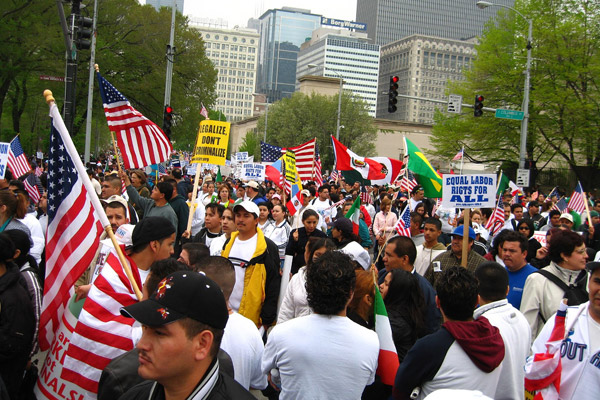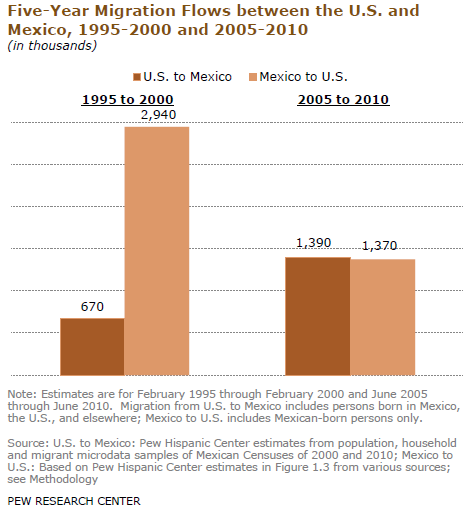
Steve Chapman is puzzled by the GOP's immigration hardliners:
They sound like a group custom-built and poll-tested to appeal to Republicans: hardworking youngsters with a powerful attachment to America, upright habits and a thirst to join the Army or enroll at State U. But the potential beneficiaries of the Dream Act are getting no love from the GOP.
That's because they are illegal immigrants — born abroad and brought here as children by parents desperate for a better life. Why they evoke scorn is a mystery.
On one hand, I don't think it's all that mysterious (poor migrant laborers always evoke scorn, including Uptown Appalachians). Unemployment is high, and unauthorized immigration is viewed as a zero-sum game. That was part of the rationale behind Alabama's aggressive new immigration laws, which haven't worked out as intended:
By the 2000s, Hispanic immigrants had moved across the state, following the construction boom in the cities, in the growing plant nurseries in the south, and on the catfish farms west of Montgomery. It wasn’t until anti-immigration sentiment spread across the country, as the recession took hold and didn’t let go, that the Republican legislators who run Alabama began to regard the immigrants they once courted as the enemy.
[snip]
“If those Alabamians on unemployment continue to not apply for jobs in construction and poultry, then [Republican politicians] are going to have to help us continue to find immigrant workers,” says Jay Reed, who heads the Alabama Associated Builders & Contractors. “And those immigrant workers are gone.”
Perhaps the pendulum will swing back, but the idea that it would cause an immediate shortfall of available low-skilled laborers was entirely predictable (PDF), and the pendulum has decades of ground to cover:
Over the last 50 years, the United States has raised the education level of its adult population dramatically. Whereas in 1960 half of US-born working-age adults had not completed high school, today the figure is just 8 percent. Though the share of low- skilled native-born individuals in the US labor force has fallen, employers continue to require less-educated workers in US agriculture, construction, food processing, building cleaning and maintenance, and other low-end jobs. Immigrants, unauthorized immigrants in particular, have stepped in to provide a ready source of manpower.
That paper, by Gordon Hanson of UC-San Diego and the National Bureau of Economic Research, goes on to argue that the best way to prevent unauthorized immigrants is to have a terrible economy—in other words, unemployment responds less to immigration than immigration responds to unemployment. Sure enough:

This should be of concern to cities, particularly ones facing a massive outflux of residents, as University of Chicago economist Gary Becker has argued, since so much of the economy (both the private and public sectors) is predicated on growth, or at least population stability:
With above replacement fertility for 150 years, many programs were instituted that worked well in growing populations, including pay-as-you-go Social Security and Medicare, he said. “Basically both of these systems tax the young to pay for the old,” Becker said.
[snip]
Immigration relieves some of the problem, leading many countries, especially in Western Europe, to reconsider limits on immigration, he said.
The massive wave of immigration in the 1990s and early 2000s plugged a hole in Chicago's declining population, but as it tailed off, so did some of the city's neighborhoods, playing a role in the population decline over the past decade:
According to the latest census, the city's Hispanic population is up only about 3 percent since 2000. But long-standing immigrant enclaves such as Little Village, Logan Square and Pilsen each lost between 8,000 and 12,000 people.
Chicago demographer Rob Paral attributed the neighborhood declines to a combination of aging families, poverty and a slowdown in immigration.
And it's not just a matter of having more employees, more homebuyers, more renters, and more shoppers. In a fascinating 2008 study, sociologist Robert Sampson (now at Harvard, formerly of the University of Chicago) argued that immigration decreased crime in Chicago:
Notably, we found a significantly lower rate of violence among Mexican-Americans compared to blacks and whites. A major reason is that more than a quarter of those of Mexican descent were born abroad and more than half lived in neighborhoods where the majority of residents were also Mexican.
Nor was it a matter of mere ethnicity:
In particular, first-generation immigrants (those born outside the United States) were 45 percent less likely to commit violence than third-generation Americans, adjusting for individual, family, and neighborhood background. Second-generation immigrants were 22 percent less likely to commit violence than the third generation. This pattern held true for non-Hispanic whites and blacks as well.
It follows, obviously, that neighborhoods with lots of immigrants were safer, when the usual variables associated with crime were considered:
Our study further showed living in a neighborhood of concentrated immigration was directly associated with lower violence (again, after taking into account a host of correlated factors, including poverty and an individual’s immigrant status). Immigration thus appeared “protective” against violence.
And the effects were strongest in high-poverty neighborhoods:
Concentrated poverty predicts more violence… but violence is lower as diversity goes up for low- and high-poverty neighborhoods alike. Interestingly, the link between lower violence and diversity is strongest in the most disadvantaged neighborhoods.
[An interesting side note from Sampson's study: last month, Mayor Emanuel visited Little Village, and said something interesting that a couple people asked about the provenance of:
“Little Village — this two-mile [stretch] — creates more sales [tax] revenue for the city of Chicago than any other place outside of the [real] Magnificent Mile,” Emanuel said, during a roundtable discussion with Hispanic business leaders at Mi Tierra restaurant, 2528 S. Kedzie.
“I keep hoping — I don’t know if anybody’s listening — that we would market it as Two Magnificent Mile because people from around the region come here to do their shopping for the goods they cannot get [elsewhere]. It reminds them of their … country of origin and they can only get it here. This is the lifeblood of the city.”
It's identical to what Sampson writes in his study, and the claim also appears in a 2006 piece in The Economist. The closest I can come to an initial source in a brief search is the Little Village Chamber of Commerce. The statistic has definitely been around a few years.]
Sampson focuses very little on causation, which is not the focus of his study, but suggests that immigrants provide balance to America's violent folkways (citing Nisbett and Cohen's Culture of Honor: The Psychology of Violence in the South). But he doesn't hold back, either, arguing that, in the context of violence, American could stand to be less American.
Either way, it would seem that one vital lesson from Chicago history in the previous century is that preventing migrant groups, be they immigrants or in-migrants, from establishing stable economic and residential footholds is disastrous public policy. In that sense, Chapman is entirely right to be mystified.


